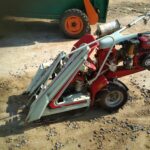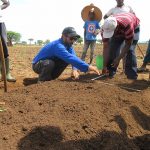AITEC: Irrigation
The Irrigation systems at the AITeC's Training, Demonstration and Research site are composed of a water reservoir, a pumping station, a filtration and water treatment unit, a regulation unit at the head of each component, a fertilization unit and drip and sprinkler irrigation. The system parts are designed to enable long term functionality with minimum maintenance requirements and minimum parts in order to ensure operation with a minimum need for spare parts.
Advantages of micro-irrigation over other types include:
- Water conservation
- Energy efficient
- Fewer weed problems
- Fertigation
- Reduced labor
- Automation
Interested in establishing an irrigation system or need technical support?
Example Irrigation System
Hectare Irrigation system at Kallamino Farm, Tigray, Ethiopia.
The Water Source
It is important to have more than one water source to ensure long term functionality and to have a reserve incase there are operational problems. The water source could be a river, lake, borehole, a dam or via a pressurized water infrastructure.
Irrigated agriculture is dependent on an adequate water supply of usable quality. Water used for irrigation can vary greatly in quality depending upon type and quantity of dissolved salts. Salts are present in irrigation water in relatively small but significant amounts. They originate from dissolution or weathering of the rocks and soil, including dissolution of lime, gypsum and other slowly dissolved soil minerals. These salts are carried with the water to wherever it is used. In the case of irrigation, the salts are applied with the water and remain behind in the soil as water evaporates or is used by the crop.
Various soil and cropping problems develop as the total salt content increases, and special management practices may be required to maintain acceptable crop yields. Water quality or suitability for use is judged on the potential severity of problems that can be expected to develop during long-term use. Having multiple water sources can enable mixing of the two for optimal use of both sources.
Reservoir
Water storage is fundamental for appropriate water management. An irrigation reservoir is designed to provide a consistent supply of irrigation water, provide water storage for the farm, and reduce energy costs. Pressurized irrigation requires that the water quality be at a high standard and clean of suspended particles, where as sedimentation may be required prior to having the water enter the reservoir. Following analysis of the water source quality a silt trap may be required prior to the reservoir. The reservoir allows maximum efficiency of the farm water sources and to enable future upgrade of the farm without additional requirements. The reservoir acts as a primary reception point and also can help to mix water of different quality sources. The reservoir is lined and sealed using a PE geo-membrane liner (HDPE) to prevent water seepage.
To understand more about the process of reservoir establishment see CultivAid’s Reservoir Establishment Guide
The size of the reservoir is based on the required volume of water of the farm. Planning of the water requirements takes into account the maximum seasonal requirements at the farm and all planning is based on these figures. This estimation is based on an evapotranspiration rate of X mm per day for a total irrigated area of Y hectares.
System head
From the Reservoir water is pumped to fields via a pumping station at the system head located near the reservoir. The system delivers pressurized water to all farm units. The system head includes pumps, a centralized filtration unit, control valves, fertigation and will connect a distribution system that will enable drip and sprinkler irrigation throughout the farm. The irrigation system provides pressurized water to all farm components. The details of the various components are provided in an engineering design of the irrigation system
In field specification
The infield specification units are control units that located in a centralized location of the agricultural plots. In order to allow good and close control of the irrigation applied to the plots there will be several specifications installed throughout the farm.
Each specification includes the following:
- Air valve
- Main Valve
- Semi-automatic filter
- Service valve
- Water meter
- Two fertilizers tank
- Pressure reducing valve
- Pressure gauge
- Vacuum backers
- PVC valves

Pipes and Emitters
From the infield unit lines distribute water to the farm’s blocks will be a PE pipe 50mm/PN6. At the end of each distributer pipe a manual flush valve will be installed in order to avoid accumulation of dirt and organic materials.
The drip line
The Drip line are the base of the drip irrigation system. It is important to know what to take into consideration when planning a system. Decisions need to be made on the drip line, wall thickness, dripper flow rate, spacing between drippers, spacing between drip lines, and specification of drip line insertion depth (if applicable).
The Sprinklers lateral pipes
Sprinkler irrigation is a method of applying irrigation water which is similar to natural rainfall. Water is distributed through the pipes and sprayed into the air through sprinklers so that it breaks up into small water drops which fall to the ground. The system must be designed to enable a uniform application of water.








